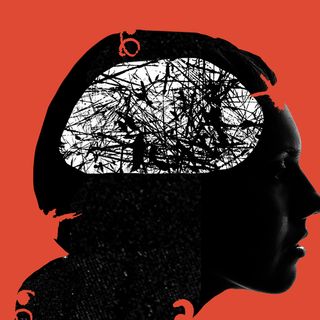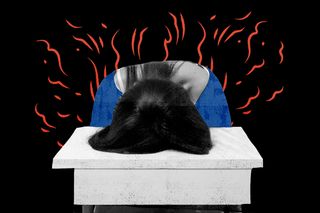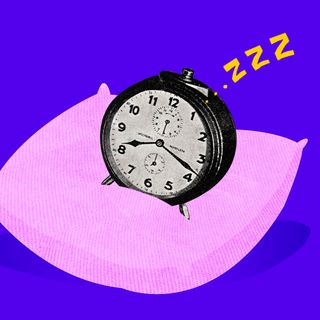
What Makes an ‘Autistic Burnout’ Different From a Regular Burnout?
Common stressors that trigger autistic burnouts can include sensory overload, social demands, and changes in routine.

I was diagnosed with workplace burnout in 2017 — just six months into my first job ever, as a finance lawyer. I immediately began researching workplace burnout. The WHO has recognized burnout as an occupational phenomenon — or, more precisely, a state “resulting from chronic workplace stress that has not been successfully managed — in the 11th Revision of the International Classification of Diseases (ICD-11). Typically, characterized by a deterioration in energy, sleep, performance, memory and concentration, and even health, workplace burnouts can also involve loss of hobbies, socializing, nurturing relationships with loved ones, and even self-care. I seemed to be experiencing most of these. And so, I immediately began the process of switching over to a less-taxing job profile. But my mental health didn’t improve.
Turns out, what I was experiencing was autistic burnout. But because my autism was still undiagnosed, it never occurred to me — or even to the professionals treating me — that what I was experiencing wasn’t, in fact, a classic case of burnout that has almost become an unfortunate rite of passage for young professionals in the post-pandemic world.
Much like the more regular forms of burnout — common among individuals in high-stress jobs or toxic work environments, and even among those in various caregiving roles — that result from chronic stress and consistent overexertion, autistic burnouts, too, can follow periods of intense stress or prolonged exposure to challenging environments. But the stressors and challenging environments that trigger autistic burnouts often include sensory overload, social demands, and changes in routine, too.
Navigating a world designed for the neurotypical population entails performing a multitude of tasks that require skills, which the aforementioned neurotypical population takes for granted. For autistic people, however, doing those things without any accommodations for their invisible disability, can be stress-inducing. And autistic individuals are already more vulnerable to stress, compared to the general population. To add to that, autistic masking — or, the conscious or unconscious suppression of natural responses by people on the autism spectrum aimed at putting on their “best normal” that is, fitting in, in order to avoid being coddled, babied, ostracized, hated on, harassed, or bullied for being different — can also induce autistic burnouts, in the long run.
Related on The Swaddle:
How Society’s Fixation on Independence as a Universal Goal Excludes Disabled, Chronically Ill People
“To fulfill their expectations of ‘normal,’ I have to mask myself to my breaking point,” Rishabh Birla, then 25, had told The Swaddle in 2021. “I think they felt I would be able to overcome my struggles after two to three months without realizing I’ll need support for the whole job,” he says, adding that their attitude impacted his ability to perform at his job. “I started hating my work and had feelings of anger and resentment because there was a lack of acceptance, support, and understanding in the workplace. I had many meltdowns and anxiety attacks while at work and during meetings.” For many autistic individuals like Rishabh, masking who they are for prolonged periods of time can lead to autistic burnout, followed by suicidal tendencies, and even the loss of one’s sense of self.
Moreover, despite autism being a legally-recognized disability, autistic individuals are often expected to somehow learn the ropes of a so-called ‘normal’ lifestyle — without taking into account that an autistic skillset can be very different from an allistic (non-autistic) one. “Executive functioning skills [like] planning, organizing, and problem-solving… don[‘t] come easily to autistic people, who can become overwhelmed by having too much to do, uncertainty and chaos… We tend to compensate… by developing routines and rules, so that, rather than having to plan and organize every time, we can apply an existing rule or routine to multiple events [to] make our day-to-day life easier. However, we find it difficult to adapt if we get interrupted or if things change during the day. Losing just one step in our usual routine can make it difficult to continue and cause stress,” explains Alice Nicholls, an autistic clinical psychologist from the U.K., who specializes in treating individuals dealing with autistic burnouts.
In addition to the symptoms associated with regular burnouts, struggling with autistic burnouts can lead people to experience a diminished ability to communicate effectively and regulate one’s emotions, a spike in social difficulties, a heightened struggle with sensory processing in the form of increased sensitivity to sensory stimuli like noise or light, and greater challenges with executive functioning. The symptoms of autistic burnout can be broadly classified into three categories: “chronic exhaustion, loss of skills, and reduced tolerance to stimulus,” as the National Autistic Society in the U.K. puts it. Basically, it becomes even more exhausting to cope with neurotypical expectations.
“Being a barista was a fun job, but the physical and sensory demands led to extreme burnout after years of hard work with little paid time off,” Bibi Bilodeau, an autistic individual, wrote. “I am retreating from any social interactions and unmotivated to follow through on any additional obligations, unsure of how to reconnect with myself and the world around me. While I want to engage with my special interests and close friends, I am resentful and lost as to where to begin. Without an intervention or complete change in routine, I am likely to continue existing in this state of burnout until my health is further compromised.”
Related on The Swaddle:
Not Every Autistic Person is a ‘Savant.’ But the Stereotype Has Significant Mental Health Costs.
But taking a break to recover from an autistic burnout isn’t easy. Autistic burnouts can last for years, and are often a combination of a multitude of triggers; since it’s not possible for most of us to go on a reptilian hibernation for months on end, given that we’re not only constrained to earn a living to sustain ourselves, but also interact socially to meet basic needs, at times. In addition, not knowing how long to pause and what can be a potential trigger that could worsen the burnout, further complicates the challenge of hitting pause and taking a breath till one feels better.
Increased sensitivity to sensory stimuli might mean that the activities one enjoyed once — like watching a movie, gaming at an arcade, or simply, going for nature walks — can suddenly become overwhelming, often leaving them with barely any avenue for recreation. Not only that, but enhanced struggles with socializing and communication that autistic burnouts can induce, also mean that hanging out with friends and family can begin to take a toll on one’s mental health. Things that can help one cope with a workplace burnout, then, don’t work for recovery from an autistic burnout. When I chose a less-taxing career to allow myself to heal, it never occurred to me to account for my sensory and social triggers. In fact, I was advised that socializing and putting myself out there would help me deal with the depression that had accompanied my burnout. I did exactly that, until I was so drained that I had neither a job, nor the energy to hunt for one actively, and felt I was good for nothing while drowning in debt.
The lack of awareness about neurodivergence, in general, among mental health professionals doesn’t help matters either. “[My] burnout ha[s] gone untreated for so long that I am now living in a perpetual state of exhaustion; burnout has become part of my ‘normal’ functioning now. My mental and physical health is suffering, and my morale is low, yet I have been existing in this way for so long that I am desensitized to the emotional and sensory pain I am constantly experiencing. My attitude has become more pessimistic, and although I am managing to survive each day, I am no longer thinking about my future plans. I may need to seek out professional help to disrupt the burnout cycle,” Bilodeau added.
Autistic burnout, essentially, results from the constant pressure to succeed in the neurotypical world and achieve the same things as neurotypical people — coupled with a lack of support from family and society. Unfortunately, this encapsulates the everyday experience of most autistic individuals, making burnouts almost inevitable for most autistic people. It is, in essence, a debilitating experience, and requires a healthy support system — so one can seek accommodations, take time off, and get support from family and friends — to recover. But in the ableist world that we live in, those can be difficult to come by.
Devrupa Rakshit is an Associate Editor at The Swaddle. She is a lawyer by education, a poet by accident, a painter by shaukh, and autistic by birth. You can find her on Instagram @devruparakshit.
Related


UTIs Are Called the ‘Honeymoon Syndrome.’ Are They Inevitable For Sexually Active Women?
